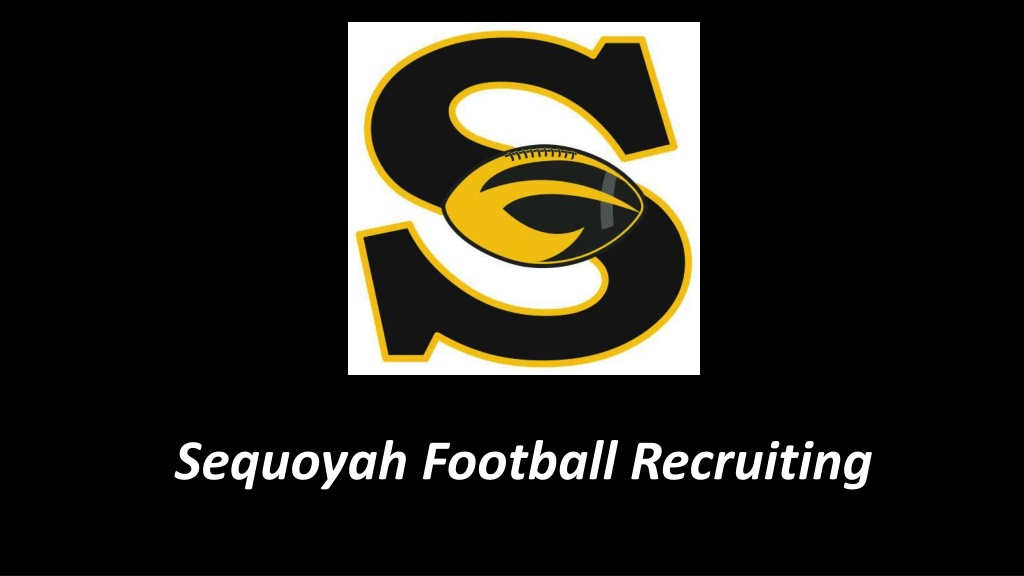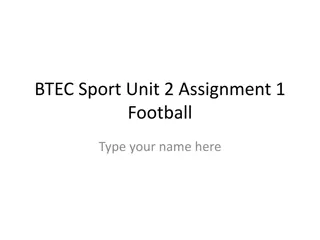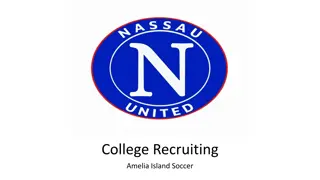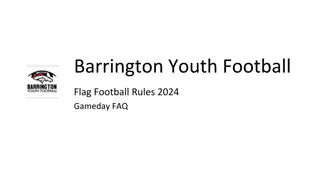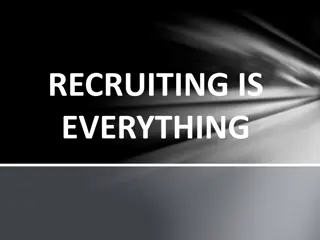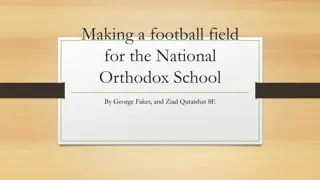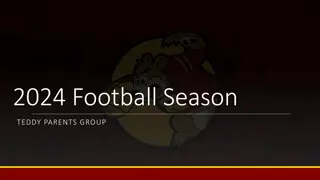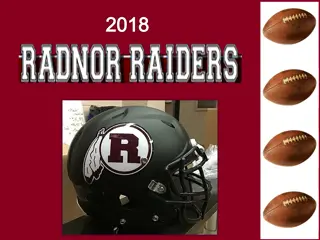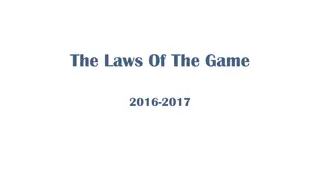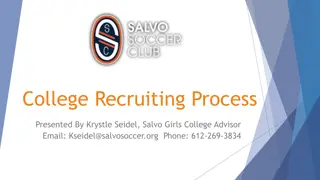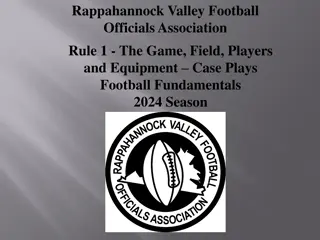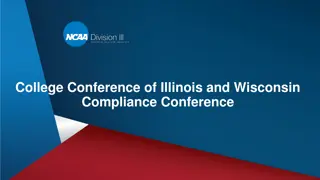Understanding College Football Recruiting Process
Explore the key aspects of college football recruiting, including scholarship breakdowns, what college recruiters look for, important statistics about senior high school football players, and an overview of different sports under NCAA Division I and II. Learn about the critical steps in the recruiting process that involve coaches, players, and parents aligning their goals and actions to maximize opportunities.
Download Presentation

Please find below an Image/Link to download the presentation.
The content on the website is provided AS IS for your information and personal use only. It may not be sold, licensed, or shared on other websites without obtaining consent from the author. Download presentation by click this link. If you encounter any issues during the download, it is possible that the publisher has removed the file from their server.
E N D
Presentation Transcript
Scholarship Breakdown Scholarship Breakdown Division I Football Bowl Subdivision (FBS) Schools 85 Scholarships Division I Football Championship Subdivision (FCS) Schools 63 Scholarships Division II Schools 36 Scholarships Division III Schools 0 Scholarships (All Scholarships are based on Academics) NAIA Schools 24 Scholarships
What College Recruiters are looking for? What College Recruiters are looking for? - Athletic ability - Look at how a player moves and reacts on the field. They also look at physical potential as well. - Academics - A s and B s and HIGH SAT and ACT scores. Most schools look at the 3 parts or the Super Score on the SAT s. The schools will then breakdown the scores on how they see fit for their school. - Character - How does he act and interact on and off the field? - Social Media - Yes! When recruiting a student/athlete college coaches will follow them on Twitter, Instagram, and Facebook. They will also look at a history of their posts and determine if they want to continue to recruit your son. - How does your son score based on the items listed above? Must score high in all 4 areas for maximum exposure.
What you need to know? What you need to know? 254,000 senior high school football players will play this year. 2,436 Division I scholarships will be awarded this year. 1.6% of High School Seniors football players will get a Division I scholarship Stats and honors may not be good enough. Colleges are in total control over the recruiting process and over the student athlete after you are awarded a scholarship. IT S A BUSINESS!
**** Sport Baseball Softball Badminton Basketball Bowling Track & Field Fencing Football Golf Gymnastics Handball Field Hockey Ice Hockey Lacrosse Rifle Rowing Skiing S****r Squash Swimming Diving Synchronized Swimming Tennis Volleyball Water Polo Wrestling NCAA DIVISION II Men's **** Women's *** NCAA DIVISION I *** Sport Men's Women's 9 7.2 Baseball Softball 11.7 12 0 10 10 5 10 0 Basketball 13 15 12.69 4.5 36 3.6 5.4 0 0 13.5 10.8 3.6 0 6.3 9 9 12.69 4.5 0 5.4 6 12 6.3 18 9.9 7.2 20 6.3 9.9 7.2 Track & Field 12.6 18 Football 85 0 Golf 4.5 6 Gymnastics 6.3 12 Field Hockey 0 12 Ice Hockey 18 18 Lacrosse 12.6 12 Rowing 0 20 S****r 9.9 12 Swimming Diving 9.9 8.1 0 9 Tennis 4.5 8 0 5 Volleyball 4.5 12 4.5 4.5 4.5 9 6 8 8 Water Polo 4.5 8 Wrestling 9.9 0
The Process The Process Step 1 - Coach, Player, and Parent have to be on the same page. This process starts when transitioning to high school. The eligibility process starts as soon as the student/athlete starts taking high school credit classes. Step 2 - This step is the most important step! When film is ready to send out the coach will send to the appropriate schools. The student athlete will start developing a resume. During this time the student athlete has to be working toward A s and B s in the classroom, they have to get ready and take the SAT s and ACT s, and they also have to be working on getting bigger, faster and stronger to perform at a high level on the field. Step 3 -This is the last step in the process. This is where the student/athlete has to figure out where they would like to go to school. The student/athlete may have choices or they may have to work harder to get to where they would like to go.
Questions for the Student/Athlete to answer Questions for the Student/Athlete to answer What is your goal or goals? Are you ready to put forth the effort to meet those goals? Are you ready to sacrifice things in your life to give yourself the best opportunity to meet your goals? Are you a person of high character? Are you going to go above and beyond to get it done? Are you willing to be a leader? Are you willing to do everything your coaches and parents ask you to do? Are you going to be a great teammate? Are you self-motivated?
Tips for the Student Tips for the Student- -Athlete When Talking with a Recruiter Athlete When Talking with a Recruiter Be yourself. Be respectful. Don t over do it. Be confident. Praise your teammates and coaches. Ask questions about the school and when you may visit the school. Show interest in each school.
How the Parent Can Help How the Parent Can Help Accept A s and B s for all classes. If the student/athlete receives a D or an F in a class have the student take the class over in summer school. Ask for your student/athletes Official Transcripts after each semester. The GPA for each core class needs to be calculated. The coaching staff will also be calculating these GPA S. SAT s and ACT s should be taken by the spring of the student-athlete s Sophomore year. The preparation for these test starts when the student enters high school. Ask for an honest evaluation of your student/athletes college playing level. Travel to and from College visits and one day college prospect camps. Encouragement and honesty in the process is the most important part a parent can have!
How the Parent Can Help How the Parent Can Help Focus on one day camps at the schools where player has an interest. Spend more time at FCS and DII programs, get on their radar as soon as possible. Listen to everyone in the process has to say. Then after you have asked all of you questions then help you son make his decision on his future. Help your son be humble thru out this entire process. Make sure he is doing everything he should be in this process. Be active and a major part of the process, but not pushy! When in doubt ask questions? Keep in mind your sons goals and his future when its all said and done!
Online Exposure for Your Son Online Exposure for Your Son Help your son develop his highlight videos to post online Keep the videos to a maximum time of 2 minutes. Use your judgment to help your son determine what is a highlight. Film needs to only include VARSITY film. Highlight videos can be made through HUDL and YouTube For a YouTube highlight video list the following information in the title of the video: Name Graduation Year Position Tom Sheehan - Class of 2017 - Wide Receiver/Defensive Back
What to Expect of the Coaches What to Expect of the Coaches Coaching staff will be a major part of the process by setting the standard for each player to be successful in the future beyond the student/athletes years at Sequoyah High School. We feel that if your son follows the values and standards set by the program that success will be a part of each player. Coach will advocate for your son. Coach will call, send film, and do whatever it takes to allow for the success of your son. Film, transcripts and letters will be sent to Colleges at all levels from NCAA to NAIA schools. Contact will be made by recruiters visiting the school, by e-mail, by texted messages, by phone, and by twitter.
NCAA Clearinghouse NCAA Clearinghouse www.clearinghouse.net www.clearinghouse.net Select Prospective Student Select Prospective Student Athletes Athletes
